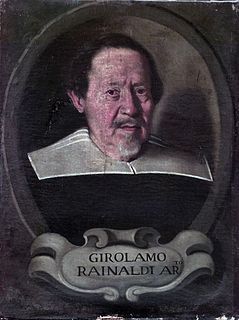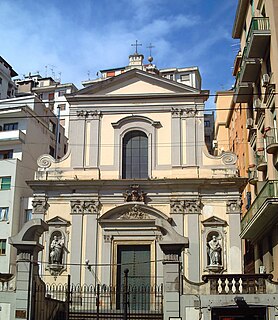
Francesco Borromini, byname of Francesco Castelli, was an Italian architect born in the modern Swiss canton of Ticino who, with his contemporaries Gian Lorenzo Bernini and Pietro da Cortona, was a leading figure in the emergence of Roman Baroque architecture.
Baccio Pontelli was an Italian architect, who designed the Sistine Chapel in The Vatican City. Baccio is an abbreviation of Bartolomeo.

Belisario Corenzio was a Greek-Italian painter, active in Venice and Naples. He is one of few Greek painters that did not belong to the Cretan Renaissance like his contemporaries of the time. He escaped the maniera greca completely. He adopted the Venetian style. Other similar Greek painters were Marco Basaiti, Ioannis Permeniates, Antonio Vassilacchi and El Greco. He was sometimes referred to as Il Greco. His teacher was prominent Venetian painter Tintoretto. In 1590, at age 32 Corenzio settled in Naples. Corenzio was influenced by Cavalier d'Arpino. He continued to flourish in the region. His apprentices included: Luigi Rodriguez, Andrea di Leone, Onofrio De Lione and Massimo Stanzione. Corenzio painted many frescos that survived today. Some of his works are in the Church of San Severino and Certosa di San Martino. His style resembles Caravaggio. An Italian legend in Naples exists involving Corenzio, Spanish painter Jusepe de Ribera, and Battistello Caracciolo. They were referred to as the Cabal of Naples. The three painters were rumored to have poisoned their competition for painting contracts. The rumors lack documented evidence. The three painters were very popular in Naples. Corenzio frescoed the Crypt that holds the remains of Matthew the Apostle at Salerno Cathedral and it depicts scenes from the Gospel of Matthew. Corenzio was one of the most celebrated fresco painters in Naples during his time. His drawings can be found all over the world namely at the Metropolitan Museum, Museo di Capodimonte and Louvre.

Girolamo Rainaldi was an Italian architect who worked mainly in a conservative Mannerist style, often with collaborating architects. He was a successful competitor of Bernini. His son, Carlo Rainaldi, became an even more notable, more fully Baroque architect.

Cosimo Fanzago was an Italian architect and sculptor, generally considered the greatest such artist of the Baroque period in Naples, Italy.

Ferdinando Fuga was an Italian architect who was born in Florence, and is known for his work in Rome and Naples. Much of his early work was in Rome, notably, the Palazzo della Consulta (1732–7) at the Quirinal, the Palazzo Corsini (1736–54), the façade of the Santa Maria Maggiore (1741–3), and the Church of Sant'Apollinare (1742–8). He later moved to Naples and notably designed the Albergo de'Poveri (1751–81), the façade of the Church of the Gerolamini, and that of the Palazzo Giordano.

Domenico Antonio Vaccaro was an Italian painter, sculptor and architect. He created many important sculptural and architectural projects in Naples. His later works are executed in an individualistic Rococo style.

Francesco de Mura was an Italian painter of the late-Baroque period, active mainly in Naples and Turin. His late work reflects the style of neoclassicism.

Giovanni da Nola (1478–1559), also known as Giovanni Merliano, was an Italian sculptor and architect of the Renaissance, active in Naples.
Giovanni Salvatore (ca.1620–ca.1688) was a Neapolitan composer and organist.

Giovanni Battista Cavagna, also known as Cavagni or Gavagni was an Italian architect, engineer, and painter mainly in Naples, but also in Rome and Ascoli Piceno, Italy.
Giovanni Angelo Criscuolo was an Italian painter active mainly in Naples.

Gabriele Agnolo, also known as Gabriele d'Angelo was an Italian architect active in Naples in the early-Renaissance manner.
Sigismondo di Giovanni was an Italian architect in Naples, Italy, working in the Renaissance style.

The church of Santi Severino e Sossio and the annexed monastery are located on via Bartolommeo Capasso in Naples, Italy.

Girolamo D'Auria (1577–1620) was an Italian sculptor, active mainly in Naples, Italy. His first name is variously used as Hieronymus, Ieronimo, Hieronimo, Jeronimo, Geronimo or Gerolamo. Girolamo's father, Giovanni Domenico D'Auria, and Annibale Caccavello, were pupils of Giovanni da Nola. his main task was sculpting funereal monuments including some in Santi Severino e Sossio, the church of Santa Maria di Monteoliveto, and the monument of Giovanni Alfonso Bisvallo, sculpted in 1617 at San Severo al Pendino.
The Palazzo Marigliano, also known as Palazzo di Capua is a Renaissance-style palace in Central Naples, Italy. It is located on the Via San Biagio dei Librai number 39.

Bartolomeo Picchiatti was an Italian engineer and architect. A short street in the Soccavo area of the city is named after him.

Giulio Cesare Fontana was an Italian architect and engineer, mainly active in Naples and its surroundings.














